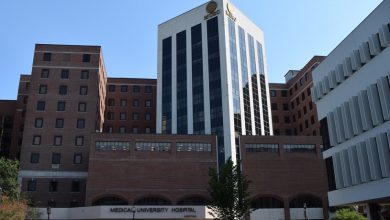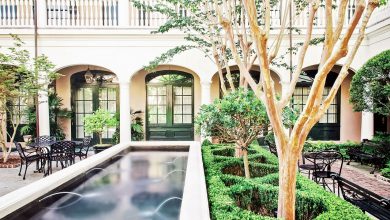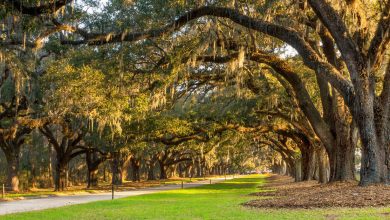A well-preserved Southern belle, Charleston personifies the romantic notion of the Old South, with its aristocratic homes surrounded by lush foliage and its atmospheric brick streets. In 1773, Charleston was described as the wealthiest town in the American South, and today, it retains perhaps more than any other, the ambiance of plantation society. A walk or a drive in a horse-drawn carriage through the Historic District, with its veranda-fronted mansions and slender church towers, makes it easy to see why the heroine of Gone with the Wind preferred to live in Charleston. Along with historic homes, plantations, and museums, Charleston’s tourist attractions include an aquarium; the USS Yorktown aircraft carrier; and Fort Sumter, where the first shots of the Civil War were fired.
A walk or carriage ride through the Historic District feels like traveling back in time to the old days of Charleston. Magnificent historic homes, churches, and other buildings (Charleston has more than 1,400 historic structures) line the streets, and a carriage ride is one of the most romantic things to do in Charleston, especially at night.
1 Waterfront Park
A place where tourists and locals gather to relax and enjoy the views of Charleston Harbor, the 12-acre Waterfront Park stretches along more than 1,000 feet of waterfront. Old-fashioned park benches and double swings face the water, where sailboats and larger ships are common sights. Fountains, including the unusual Pineapple Fountain, are lighted at night, and seasonal flower gardens add splashes of color. The park’s central location near the City Market and historic sights, along with its free wifi, make it even more popular.
Address: 1 Vendue, Charleston, South Carolina
2 Middleton Place Plantation
Nothing rings with the aura of the Old South like a great plantation, and Charleston has several to show off. In addition to its fully furnished plantation house, Middleton Place is further distinguished by America’s oldest landscaped gardens. Stretching in a magnificent series of descending terraces, hedged galleries, and pools, the grounds show off their symmetrical 17th-century European design. The gardens bloom year-round with rare camellias in the winter and azaleas in the spring.
On a tour of the 1755 house, you’ll learn about four generations of the Middletons and their slaves as you see furniture, silver, rare books, porcelain, and portraits maintained by the same family for more than three centuries. The Plantation Stableyards recreate life outside the great house, with costumed interpreters demonstrating skills and trades that include blacksmithing, pottery, carpentry, cooperage, and weaving, activities that would have been carried on by slaves on a Low Country rice plantation in the Antebellum years.
3 Magnolia Plantation & Gardens
It’s not just garden lovers who will be enchanted by the year-round beauty of Magnolia Plantation’s extensive gardens. These are America’s oldest publicly accessed gardens, first opened to visitors in 1870, although portions of them date to two centuries earlier. They are also the nation’s last large-scale Romantic-style garden, in contrast to most show gardens where nature is controlled and shaped by formal beds, paths, and landscaping. Nurtured by generation after generation of the same family, the gardens have grown as each subsequent owner added new features. You can take a guided tour of the house, visit an Antebellum cabin, take a boat tour, see exhibits, and take younger visitors to a nature center and petting zoo.
Address: 3550 Ashley River Road, Charleston, South Carolina
4 South Carolina Aquarium
One of the most popular things to do in Charleston with kids is the South Carolina Aquarium. Despite its name, it isn’t just home to underwater creatures. Birds, land-dwelling mammals, plants, and reptiles join the sea inhabitants in every kid’s favorite Charleston attraction. The emphasis is on participation, so in addition to the two-story, 385,000-gallon aquarium tank, where there are daily interactive shows, you’ll find Shark Shallows, where you can touch sharks and rays, and a touch tank with starfish and other creatures. To get a feel for the behind-the-scenes animal care, visitors can tour the aquarium’s Sea Turtle Hospital – South Carolina’s only hospital for sick and injured sea turtles. The aquarium’s best-loved resident is Caretta, a 220-pound loggerhead sea turtle that lives in the Great Ocean Tank.
5 Old Slave Mart Museum
In the heart of the French Quarter, near the French Huguenot Church, the Old Slave Mart Museum is set inside the building where slaves were auctioned prior to the Civil War. The tour is self-guided, with signage explaining the history, as well as personal accounts of slaves, artifacts, and audio and visual exhibits. It is a small but deeply affecting museum that gives a sobering view of history. A block away is the Old Exchange & Provost Dungeon, where costumed guides relate a history of pirates and patriots who were once imprisoned here.
Address: 6 Chalmers Street, Charleston, South Carolina
6 USS Yorktown and Patriots Point
Just across Charleston Harbor from the Historic District is Patriots Point, where you can board the USS Yorktown. This immense vessel was the tenth aircraft carrier to serve in the United States Navy, receiving the Presidential Unit Citation and earning 11 battle stars for service in World War II, as well as five battle stars for service in Vietnam. She was also the vessel selected to recover the Apollo 8 astronauts, and even made a film debut in the 1944 documentary The Fighting Lady. The USS Yorktown was retired to Patriots Point Naval and Maritime Museum in 1975. While at Patriots Point, you can also tour aircraft, submarines, and other maritime exhibits.
Address: 40 Patriots Point Road, Mount Pleasant, South Carolina
7 Boone Hall Plantation
One of America’s oldest working plantations, the 1681 Boone Hall is best known for its moss-draped, three-quarter-mile Avenue of Oaks and for preserving original slave cabins. The highly photogenic trees that frame the approach to Boone Hall were planted in 1743 by the son of Major John Boone, the original owner. Crops have been continuously grown here for more than three centuries, and you can buy fruits, berries, and vegetables at their Boone Hall Farms Market, close to the plantation on Hwy. 17.
Address: 1235 Long Point Road, Mount Pleasant, South Carolina
8 Ravenel Bridge
The Arthur Ravenel Jr. Bridge across the Cooper River, joining downtown Charleston to Mount Pleasant, became a well-loved landmark immediately upon its completion in 2005. Its sleek cable-stay design is more than just a pretty bridge: it is built to withstand winds in excess of 300 miles per hour and a 7.4-scale earthquake, and even to prevent collisions with ships. Along with its multiple traffic lanes, the bridge includes a shared bicycle-pedestrian path named Wonders’ Way, and walking or biking across it is a favorite activity for its sweeping views of Charleston.
9 Drayton Hall
The elegant Drayton Hall is the oldest unrestored plantation house in America still open to the public. Similar to other local plantations, Drayton Hall offers guided house tours, but where it differs is that the house itself (its walls, floors, and fireplaces) remains virtually undisturbed, giving a rare glimpse into the past. Its exquisite interiors are untouched, featuring ornamental details and original 18th-century craftsmanship. Dating from 1738, Drayton Hall Plantation was one of the few to survive the Civil War intact. Endearing personal touches remain, such as a children’s growth chart dating back more than 300 years. The plantation’s African-American cemetery, dating from about 1790, is among the oldest African-American cemeteries in the nation still in use.
10 Fort Sumter National Monument
The American Civil War began on April 12, 1861 at Fort Sumter, when the Confederacy pummeled the federal fort in Charleston Harbor. The fort ruins are well preserved, and National Park Rangers tell the story of Fort Sumter and how it helped shape history. Visitors must ride to the island by boat, from the Visitor Education Center downtown at Liberty Square or from Patriots Point.
11 The Charleston Museum
Known as “America’s First Museum,” The Charleston Museum was founded in 1773 under the Charleston Library Society. Its collections are vast, arranged in a number of permanent exhibits that begin with Native Americans and early settlers in the Lowcountry History Hall, where you can see rare slave badges and early tools used in rice growing. Exhibit areas continue to illustrate early weaponry, life during the Revolution, and Charleston’s role in the Civil War. The Early Days gallery displays the often quirky collections of 19th-century world travelers, including an Egyptian mummy and case and Greek and Roman antiquities.
The Loeblein Gallery of Charleston Silver shows southern-made silver through the Victorian era (including George Washington’s christening cup), and the Historic Textiles Gallery shows changing examples from the museum’s outstanding collection of historic needlework, costumes, and textiles. Kidstory brings the history of Charleston and the Lowcountry to life in hands-on exhibits.
Address: 360 Meeting Street, Charleston, South Carolina
12 Nathaniel Russell House and Aiken-Rhett House
After walking past so many aristocratic mansions with their verandahs and imposing facades, you’ll certainly be curious to look inside. A number are open as house museums, some furnished and decorated as they were in their heyday, and all giving a glimpse of upper-crust life in old Charleston. Two of these are maintained by the Historic Charleston Foundation. The 1808 Nathaniel Russell House, at 51 Meeting Street, is among America’s most important Neoclassical homes, known for its free-standing, three-story staircase and its ornate plasterwork. It is furnished with part of the organization’s valuable collection of fine and decorative art, and is also especially known for its beautiful gardens. Another notable Foundation property is the Aiken-Rhett House, at 48 Elizabeth Street. The 1820 home is unique in having remained in the same family for 142 years, until it became a museum.
13 Calhoun Mansion
Representing a different era from the Historic Charleston Foundation’s antebellum homes, the 1876 Italianate Calhoun Mansion is a prime example of Gilded Age décor and taste. Some of its 30 main rooms have Tiffany decorations, and they are filled (some might say overfilled, but that was the taste of the times) with outstanding collections of decorative arts of the late 19th-century era. The ballroom has a ceiling 45-feet high, and behind the mansion are formal English gardens.
Address: 16 Meeting Street, Charleston, South Carolina
14 The Battery and White Point Garden
The promenade along the seawall washed by the Ashley and Cooper Rivers as they meet and form Charleston Harbor became a public garden in 1837 but was fortified as Battery Ramsey when the Civil War began. Historic mortars and cannons from that war as well as a Confederate monument are displayed here, but the main reason the park is a favorite place for tourists to stroll is that it is bordered by some of Charleston’s grandest stately homes and mansions and offers a spectacular view of Fort Sumter and Charleston Harbor.
Address: Murray Blvd, Charleston, South Carolina
15 Cathedral of St. John the Baptist and Historic Churches
Remarkable historic churches are scattered throughout Charleston, and each has a story to tell. Among the city’s most interesting is the brownstone Cathedral of St. John the Baptist, a neo-Gothic structure built to replace the previous cathedral, which was lost in the devastating 1861 fire that destroyed much of the city. The pews are carved from Flemish oak, and the three original altars are made of white marble. It has some notable stained glass windows as well.
Among Charleston’s other interesting churches are the Romanesque-style Circular Congregational Church, with colonial burial grounds dating from 1695, and the French Huguenot Church, home to the oldest continuously active Huguenot congregation in the United States. St. Michael’s Episcopal Church, a National Historic Landmark, dates to 1751 and is known for its four stained glass windows by Tiffany Company of New York and for the cedar pew where George Washington sat in 1791.
Address: 120 Broad Street, Charleston, South Carolina
16 Festival of Houses and Gardens
Organized by the Historic Charleston Foundation, the Annual Festival of Houses and Gardens features tours and educational programs specifically geared toward architectural and gardening enthusiasts. Held during the peak of the blooming season, the Festival offers guests the rare chance to see inside the city’s private homes and gardens. Approximately 150 of America’s most distinctive historic houses, spread throughout 12 colonial and antebellum neighborhoods, are open to tour.
Where to Stay in Charleston for Sightseeing
The main attractions in Charleston are clustered around the Historic District, and staying in this area of downtown will allow you to experience the best of the city. History buffs will want to base themselves in the heart of the Historic District; families may choose to stay to the northeast, closer to the aquarium; and budget seekers will find themselves five to seven miles out, and across the river to the west. The free DASH trolley operates three routes in the downtown area. Below are some highly-rated hotels in convenient locations:
-
- Luxury Hotels: The elegant French Quarter Inn offers exemplary service, luxurious accommodations and amenities, and is located in the center of the Historic District, just steps from the Charleston City Market. A five-minute walk from the beautiful Waterfront Park, The Spectator Hotel is a stylish new boutique hotel that assigns a butler to each guest. A luxury option, perfect for those who prefer to have full kitchen amenities, is The Restoration. This newly reopened property is on trendy King Street, Charleston’s premier shopping area.
-
- Mid-Range Hotels: Close to the South Carolina Museum, the boutique Indigo Inn features 41 rooms in an 1850s era restored warehouse. Steps to the interesting shops of King Street, the King Charles Inn has an outdoor pool and terrace. The new Hyatt House Charleston is a large hotel in the Upper King District, about a 15-minute walk from the heart of the Historic District and about a mile from the South Carolina Aquarium.
- Budget Hotels: The Comfort Suites West of the Ashley is on Highway 17, five miles out from downtown. This hotel has large modern rooms at an attractive price. In the same area and offering a large outdoor pool, the Holiday Inn Express is a good option for families. A few miles closer to downtown is the newly renovated Sleep Inn, with cozy rooms and an outdoor pool.





Leave a Reply
You must be logged in to post a comment.